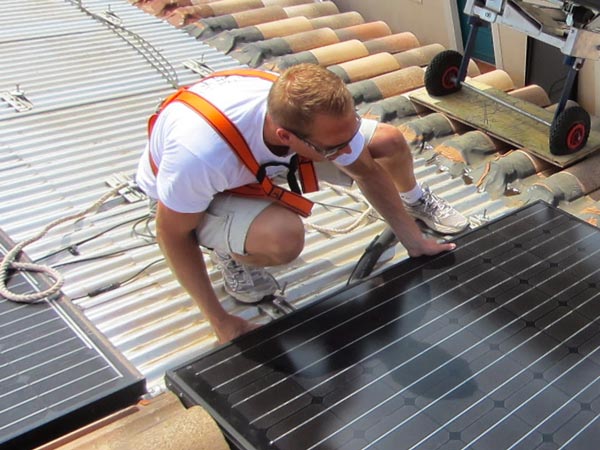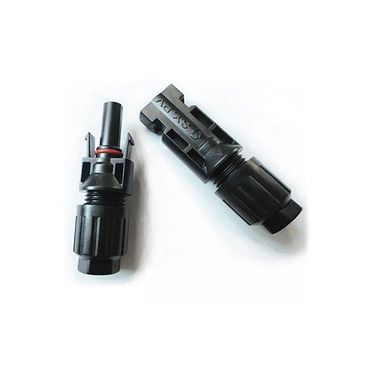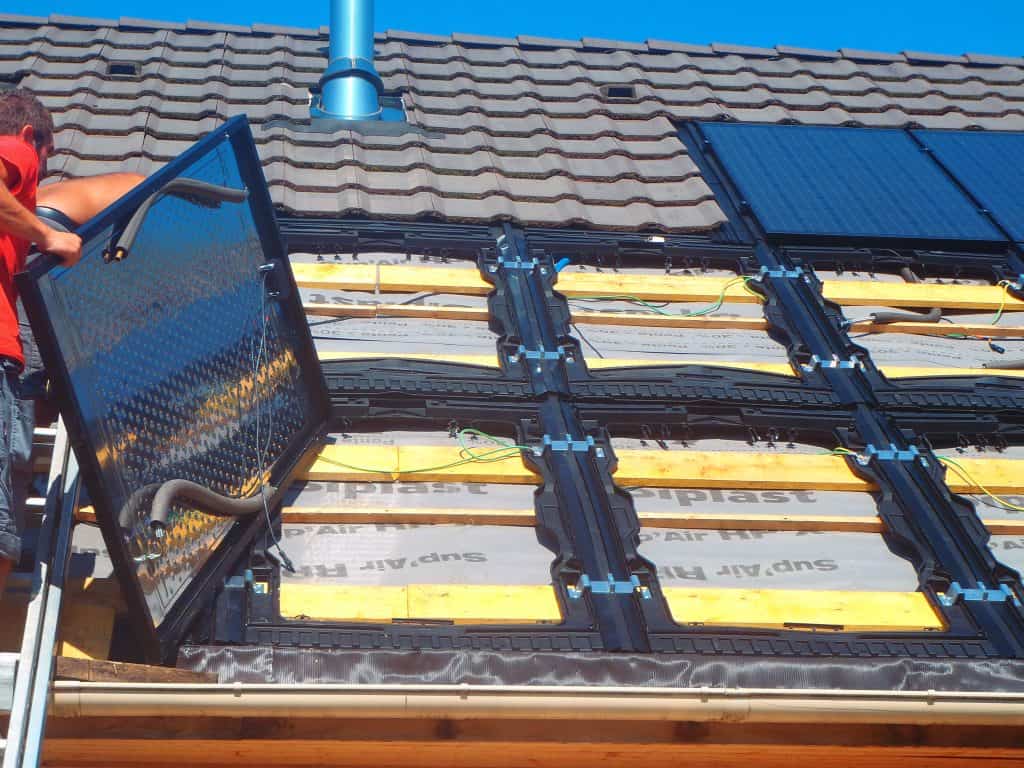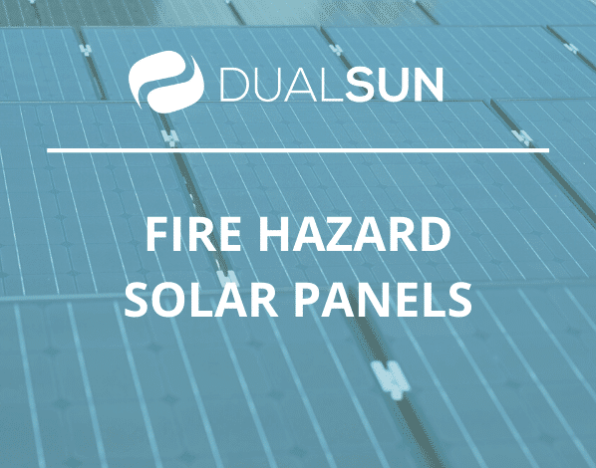Solar panels pose an extremely low fire hazard. In fact, Photon magazine has recorded no more than 1 incident per 10, 000 installations. So a house equipped with properly installed solar panels will not catch fire.
In any event, there are a few basic precautions you can take just in case. Read on to find out.
First off, it must be noted that photovoltaic solar panels cannot start a fire in and of themselves.
However, if a photovoltaic installation malfunctions, some of its components may become flammable.
The following issues were detected in the rare incidence of solar panel fires:
- Poorly installed panels.
- Defective connections (sensors, junction box).
Incorrect installation of the photovoltaic system
It is important to note, that in practice, the main risk of solar panel fire is related to poorly-installed solar collectors.

For instance, the incorrect seaming of connectors may generate electrical arcing, meaning a release of considerable heat. If this occurs, it may cause overheating and a fire.
It is therefore crucial to leave the installation of solar panels in the hands of a professional who will comply with the installation instructions and use the appropriate tools.
A defective photovoltaic junction box
In terms of components, the main cause of fire outbreaks is linked to an overheating defective junction box.

For reference, the junction box is located on the rear side of the solar panel and enables electrical connection via a specific MC4 connector type or an upgraded variant. As it happens, the electrical connection system is designed to prevent fire.
In 2012, fire incidents were reported in relation to photovoltaic installations equipped with defective Scheuten Multisol® modules manufactured between September 2009 and October 2010 and Solexus junction boxes. This type of accident became a veritable textbook case for manufacturers. Fortunately, this problem has not reemerged in years.
[et_bloom_inline optin_id=”optin_14″]
How to avoid the risk of a photovoltaic panel fire
To avoid all risk of photovoltaic panel fire incidents, a set tools and norms have been outlined for manufacturer and installers alike. All professionals are expected to refer to and comply with them.
As a reminder and an aid to understanding the rest of the article, we would like to point out that the electrical grid generates alternating current whereas solar panels generate direct current. The photovoltaic inverter is there to transform the direct current into alternating current that can be fed into the grid.
Respect the standards set out for photovoltaic panels
Let us consider the alternating current side. The design and utilization of photovoltaic installations must comply with certain regulations, namely the French standards NFC 15-100, NF 14-100, NF C13-100 and NF C13-200. These standards certify the quality of the components as well as the proper assembly of the solar panels. They must be complied with in all electrical installations.

The French guide UTE C15-712-1 (for photovoltaic installations connected to the public distribution network) provides the necessary measures to limit the risk of electric shock and fire incidence in solar panels. The solar installer must comply with these specifications in order to perform a proper installation.
Monitor the inverters and the junction boxes
In a grid-connected installation, the electrical installation must be isolated from the equipped building. To do this, the alternating current (AC) side of the installation must be switched off with the help of the AGCP (main circuit breaker).
The inverters or the micro-inverters must comply with standard VDE 0126. This means that power generation immediately stops when the current in the grid is interrupted. On the other hand, if there is no mains supply presence, an isolation unit interrupts the feeding of photovoltaic output into the mains. Adherence to this standard is essential in order to ensure a safe intervention from the fire department.
The junction boxes are located at the back of the panel and must be carefully assembled to avoid electrical arcing and short circuits.
Firefighter response to a solar panel fire
Firefighters know exactly how to respond to this type of incident and are trained in this procedure. Prior to any intervention on a panel-equipped home, they identify:
- The implemented technology (photovoltaic, thermal, hybrid).
- The installation type (roof-integrated, superimposed, on the ground).
- Whether or not the installation is connected to the grid.
Immediately disconnect the solar panels in case of fire
To avoid the risk of electric shock, the panels must be disconnected as quickly as possible. The fire and rescue responders on site will handle this operation.
Let us consider the case of a solar installation catching fire in the middle of the day after a fire breaks out on the roof. At such time, the system would continue generating electricity for as long as there is sun or light and the panels remain connected.
How to react in this kind of emergency? For starters, the solar panels should under no circumstances be doused with water before they are disconnected. In order to safeguard the intervention of the firefighters, the installation must be shut off as near as possible to the panels:
- In the direct current part, meaning the side powered by the solar panels, a built-in automatic switch-off device is installed on the equipment as required by the DIN VDE 126-1-1 standard.
- In the alternating current part, meaning the side supplied by the grid, there is a disconnecting switch located in the AC protection unit.
[et_bloom_inline optin_id=”optin_14″]
Dualsun hybrid panels offer maximum security
System safety from the design stage
For starters, our Dualsun hybrid solar panel has been IEC and Solar Keymark certified, thus guaranteeing its high quality and reliability.
Additionally, all of our heat exchangers undergo a leakage test before leaving our factory. Our aging tests ensure the absence of undue leakage of the heat exchanger over time.
Furthermore, the sheaths applied to the electrical connector provide electrical insulation from external forces, thus eliminating the risk of short-circuiting.
Lastly, the junction box and the cables from the photovoltaic part of the system are completely sealed off (as per IP 67 specifications). As a matter of fact, there are several electrical insulation layers between the cells and the water. Our entire electrical connection system meets current safety regulations.
It is also important to note that the thermal part of the Dualsun solar panels is not at risk of overheating. This is because the system has a low stagnation temperature that does not exceed 70°C.For further reading, we recommend the following articles:

Aucun commentaire pour le moment